Deacon John Bailey House

Deacon John Bailey House is a residential building in Portland, Maine, United States. The home, which is located at 1235 Congress Street, was built between 1730 and 1756, when the city was part of the Province of Massachusetts Bay. Greater Portland Landmarks, a preservation group, calls it "one of the most important Pre-Revolutionary War-era houses in the city." It is believed that the bricks for the home's floor and hearth were fired on-site. Originally a one-storey property, a second level was added by John Bailey's son, Benjamin, in 1807. In 1899, the property's location, on the northern side of Congress Street (then at number 1175), was given as being "between Libby's Corner and Bradley's Corner." It was occupied at the time by Helen M. Bailey, great-granddaughter of John and sister of previous owner, Captain Francis H. Bailey. After John's death, the home passed to son Benjamin, then to grandson Jeremiah. It is one of the few buildings to have survived the 1775 burning of Falmouth and the great fire of 1866. The Historic American Building Survey surveyed the building in 1936. As of 2024, the property is owned by Heller Washam Antiques.
Excerpt from the Wikipedia article Deacon John Bailey House (License: CC BY-SA 3.0, Authors, Images).Deacon John Bailey House
Congress Street, Portland
Geographical coordinates (GPS) Address External links Nearby Places Show on map
Geographical coordinates (GPS)
| Latitude | Longitude |
|---|---|
| N 43.6577 ° | E -70.29028 ° |
Address
Congress Street 1235
04102 Portland
Maine, United States
Open on Google Maps






